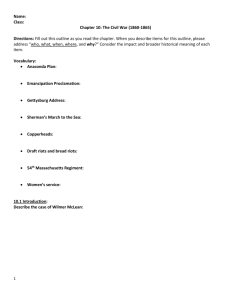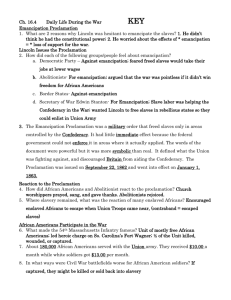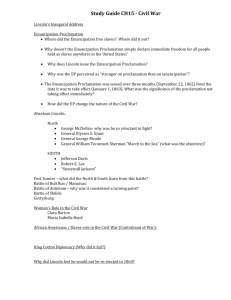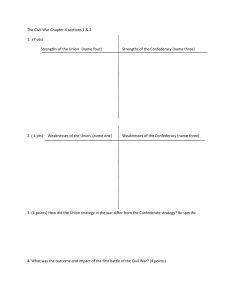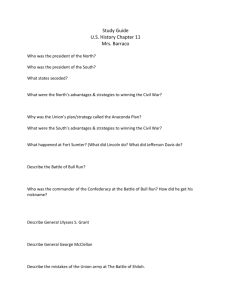USHC - 4.3
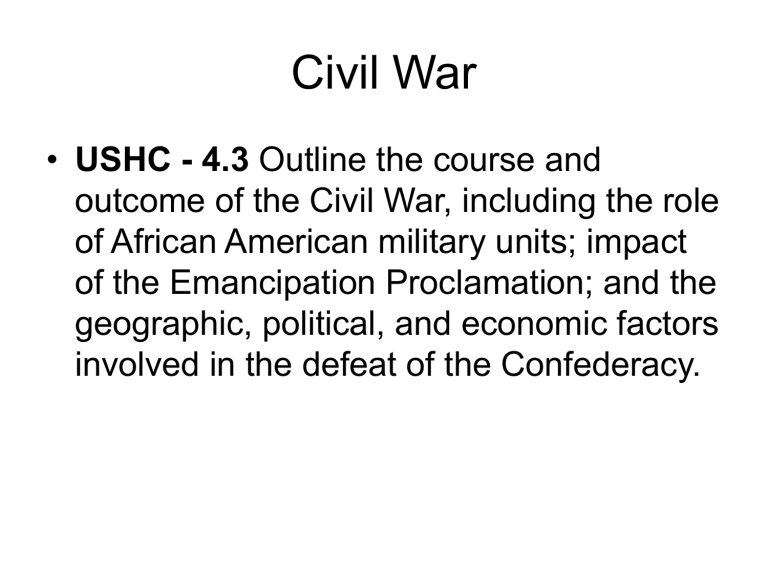
Civil War
• USHC - 4.3 Outline the course and outcome of the Civil War, including the role of African American military units; impact of the Emancipation Proclamation; and the geographic, political, and economic factors involved in the defeat of the Confederacy.
USHC - 4.3 Outline the course and outcome of the Civil War, including the role of African American military units; impact of the Emancipation Proclamation; and the geographic, political, and economic factors involved in the defeat of the
Confederacy.
• The course and outcome of the Civil War depended upon the economic resources of the
North and the South, the geographic factors that influenced strategy and the military and political leadership that influenced public support.
– The Union had far greater economic resources including industrial capacity, miles of railroad tracks, manpower and a navy.
– The South depended on the power of cotton and their trading relationship with Great Britain to provide the manufactured goods and ships that they lacked.
Union Navy
Union Army
Southern Cotton
USHC - 4.3 Outline the course and outcome of the Civil War, including the role of African American military units; impact of the Emancipation Proclamation; and the geographic, political, and economic factors involved in the defeat of the
Confederacy.
– However the Union’s strategy to blockade southern ports effectively disrupted this trade throughout the war.
– The North’s offensive strategy was based on geography and included splitting the South at the Mississippi River and taking the capitol at
Richmond [Anaconda Plan].
Anaconda Plan
USHC - 4.3 Outline the course and outcome of the Civil War, including the role of African American military units; impact of the Emancipation Proclamation; and the geographic, political, and economic factors involved in the defeat of the
Confederacy.
– The South’s strategy was mainly to defend their region until the North tired of the war effort and quit. Confederate forces invaded the North twice in an effort to gain foreign support and hasten the end of the war but were repulsed at Antietam and defeated at
Gettysburg.
Battle of Gettysburg
Antietam
USHC - 4.3 Outline the course and outcome of the Civil War, including the role of African American military units; impact of the Emancipation Proclamation; and the geographic, political, and economic factors involved in the defeat of the
Confederacy.
• Initially the South enjoyed advantages in both military leadership and geography .
– They were able to effectively move their men and materiel via railroads between battle fronts in the east and the west under the effective leadership of Robert E. Lee.
– Southerners were also more familiar with their home terrain.
USHC - 4.3 Outline the course and outcome of the Civil War, including the role of African American military units; impact of the Emancipation Proclamation; and the geographic, political, and economic factors involved in the defeat of the
Confederacy.
• The North, however, had the advantage in political leadership .
– Jefferson Davis, the Confederate president defending the states’ rights argument, was not able to get the states of the Confederacy to effectively work together to pursue the war effort.
– Abraham Lincoln was able to articulate the purpose of the war as the preservation of the Union and democracy and to retain sufficient public support to continue the fight despite initial military defeats.
USHC - 4.3 Outline the course and outcome of the Civil War, including the role of African American military units; impact of the Emancipation Proclamation; and the geographic, political, and economic factors involved in the defeat of the
Confederacy.
– Lincoln also demonstrated his political skills by his handling of the issue of emancipation of the slaves.
• Lincoln initially hesitated to free the slaves because he feared this would undermine the unity of the North.
• When emancipation was announced, it was promoted as a ‘military measure’ against the South.
– However, the Emancipation Proclamation was a diplomatic and political document.
• By making a goal of the war the liberation of slaves,
Lincoln made it impossible for the British, whose population was strongly opposed to slavery, to continue to support the Southern war effort.
USHC - 4.3 Outline the course and outcome of the Civil War, including the role of African American military units; impact of the Emancipation Proclamation; and the geographic, political, and economic factors involved in the defeat of the
Confederacy.
– By announcing his intention to issue the Emancipation
Proclamation in the fall and not making it effective until the first of the year, Lincoln gave the South a last chance to make peace and keep their slaves.
• The Emancipation Proclamation did not immediately free the slaves.
– It did not attempt to free slaves in the regions under Union control or in the border states, those slaves states that did not secede from the Union.
– Only states in rebellion on January 1, 1863 were commanded to free their slaves and Confederates were not likely to obey the President of the United States.
– Slaves were then freed as their homeland was captured by
Union forces or as they fled to Union lines.
USHC - 4.3 Outline the course and outcome of the Civil War, including the role of African American military units; impact of the Emancipation Proclamation; and the geographic, political, and economic factors involved in the defeat of the
Confederacy.
• Finally, freedom for all slaves was formally legalized by the Thirteenth Amendment at the end of the war.
• The Emancipation Proclamation allowed African
Americans to enlist in the United States army as a war measure.
– With the help of abolitionists, several African
American units were formed, most notably the 54 th
Massachusetts regiment.
– African American soldiers served with distinction.
USHC - 4.3 Outline the course and outcome of the Civil War, including the role of African American military units; impact of the Emancipation Proclamation; and the geographic, political, and economic factors involved in the defeat of the
Confederacy.
– However, they served in segregated units under the command of white officers.
– They were poorly supplied and paid less than their white counterparts.
USHC - 4.3 Outline the course and outcome of the Civil War, including the role of African American military units; impact of the Emancipation Proclamation; and the geographic, political, and economic factors involved in the defeat of the
Confederacy.
• President Lincoln effectively exercised his power as commander in chief and eventually found the right general to win the war.
– Lincoln was frustrated by his generals until he named Ulysses S. Grant, who had been successful at Vicksburg in cutting the South in half at the Mississippi River, as commander of northern forces.
Vicksburg
Vicksburg
USHC - 4.3 Outline the course and outcome of the Civil War, including the role of African American military units; impact of the Emancipation Proclamation; and the geographic, political, and economic factors involved in the defeat of the
Confederacy.
– Grant changed the strategy to ‘total war’.
– William Tecumseh Sherman’s ‘March to the
Sea’ and Grant’s unrelenting attacks and siege at Petersburg strained the dwindling economic resources and manpower of the
South and brought surrender at Appomattox
Courthouse.
Sherman’s March to the Sea
Civil War Medicine
